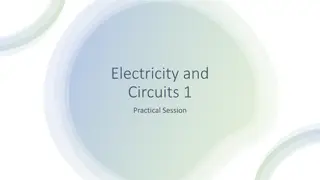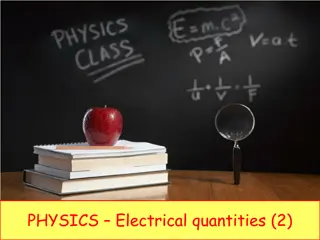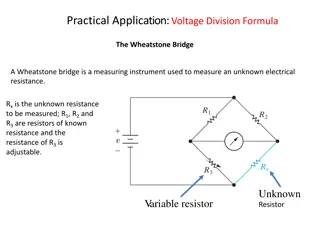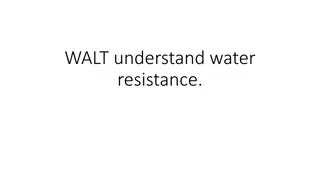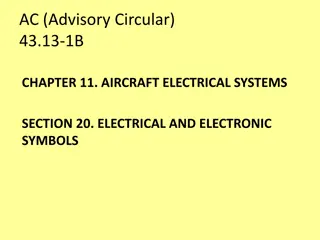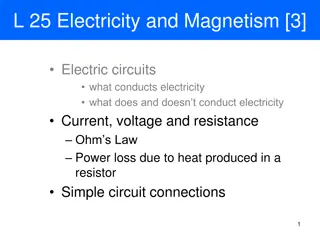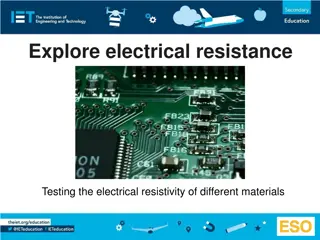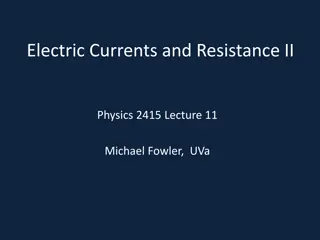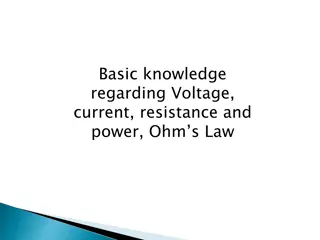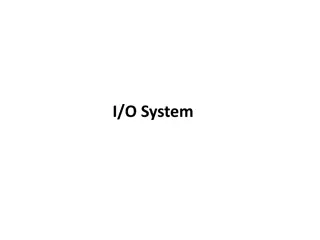Understanding Electrical Power and Resistance in Devices
The heating effect of an electric current is explored through the concepts of electrical power and resistance in devices like kettles and toasters. Learn about calculating power consumption, energy usage, and the importance of electrical power ratings displayed on devices.
Download Presentation

Please find below an Image/Link to download the presentation.
The content on the website is provided AS IS for your information and personal use only. It may not be sold, licensed, or shared on other websites without obtaining consent from the author. Download presentation by click this link. If you encounter any issues during the download, it is possible that the publisher has removed the file from their server.
E N D
Presentation Transcript
The heating effect of an electric current House wiring is made of copper wire and is designed to let electric current flow through it easily. It is said to have a low resistance. However, the parts of some devices such as the heating elements of kettles and toasters are designed to have a high resistance. Resistance causes heat energy to be produced when an electric current flows. The greater the resistance and current the hotter the heating element may become. A kettle s heating element
Electrical power (P) The electrical power, P of a device is equal to the rate at which it transforms energy from electrical to some other form (such as heat). electrical power = energy transferred time electrical power is measured in watts (W) energy in joules (J) time in seconds (s) also: 1 kilowatt (kW) = 1 000 watts 1 megawatt (MW) = 1 000 000 watts
Electrical power ratings These are always shown on an electrical device along with voltage and frequency requirements.
Electrical power examples Device Power rating Torch 1W Energy efficient lamp 11 W 300 W Desktop computer Hairdryer 1 000 W or 1 kW 2 000 W or 2 kW Electric kettle 5 kW Electric shower
Question 1 Calculate the power of a light bulb that uses 1800 joules of electrical energy in 90 seconds.
Question 1 Calculate the power of a light bulb that uses 1800 joules of electrical energy in 90 seconds. electrical power = electrical energy time = 1800 J 90 s electrical power = 20 watts
Question 2 Calculate the energy used in joules by a heater of power 3kW in 1 hour.
Question 2 Calculate the energy used in joules by a heater of power 3kW in 1 hour. electrical power = electrical energy becomes: electrical energy = power x time = 3 kW x 1 hour = 3000 W x 3600 seconds electrical energy used = 10 800 000 joules (or 10.8 MJ) time
Complete: Complete Electrical energy used 600 J Time Power 20 s 15 s 500 W 800 J 20 W 60 kJ 10 minutes
Complete: Answers Electrical energy used 600 J Time Power 20 s 30 W 15 s 500 W 7 500 J 40 s 800 J 20 W 100 W 60 kJ 10 minutes
Electrical power, P electric current, I and voltage V electrical power = current voltage P = I x V electrical power is measured in watts (W) electric current in amperes (A) voltage in volts (V)
Question 1 Calculate the power of a 230V television that draws a current of 2.5A.
Question 1 Calculate the power of a 230V television that draws a current of 2.5A. electrical power = current voltage = 2.5A x 230V power = 575W
Question 2 Calculate the current drawn by a kettle of power 2kW when connected to the mains 230V power supply.
Question 2 Calculate the current drawn by a kettle of power 2kW when connected to the mains 230V power supply. P = I x V becomes: I = P V = 2kW 230V = 2000W 230V electric current = 8.7A
Fuse ratings The equation: current = electrical power voltage is used to find the fuse rating of a device. The correct fuse rating is that next above the normal current required by an appliance. A 3-pin plug will normally contain a 3A, 5A or 13A fuse. Example: A 5A fuse should be used with a device that needs a current of 3.5A.
Question Fuses of 3A, 5A and 13A are available. What fuse should be used with a 60W, 230V lamp?
Question Fuses of 3A, 5A and 13A are available. What fuse should be used with a 60W, 230V lamp? I = P V = 60W 230V = 0.26A Fuse to be used = 3A
Complete: Answers All of the devices below are 230V mains appliances. Device and power (W) Normal current (A) Fuse choice from: 3A, 5A or 13A Computer; 300W 1.3 A Microwave; 900W 3.9 A Charger; 10W 0.04A 8.7A Heater; 2kW Maximum power? 2990W 13A
Complete: Answers All of the devices below are 230V mains appliances. Device and power (W) Normal current (A) Fuse choice from: 3A, 5A or 13A 3A Computer; 300W 1.3 A Microwave; 900W 3.9 A 5A Charger; 10W 0.04A 8.7A 3A 13A Heater; 2kW Maximum power? 2990W 13A 13A
Choose appropriate words to fill in the gaps below: Electric power is the rate of conversion of electrical _______ to some other form and is measured in ______. Electrical power is equal to electric current __________ by voltage. The greater the _______ for the same voltage the _________ is the current drawn. The correct fuse for a device is the next available value _____ the normal current drawn by a device. The maximum fuse rating for a 3-pin plug is _______ for an appliance of power about _______. WORD SELECTION: multiplied above 13A watts power greater 3kW energy
Choose appropriate words to fill in the gaps below: Electric power is the rate of conversion of electrical _______ to some other form and is measured in ______. energy watts Electrical power is equal to electric current __________ by voltage. The greater the _______ for the same voltage the _________ is the current drawn. greater multiplied power The correct fuse for a device is the next available value _____ the normal current drawn by a device. The maximum fuse rating for a 3-pin plug is _______ for an appliance of power about _______. 3kW above 13A WORD SELECTION: multiplied above 13A watts power greater 3kW energy
Electrical energy E E = I x V x t electrical energy (E ) is measured in joules (J) electric current (I ) in amperes (A) voltage (V ) in volts (V) time (t ) in seconds (s)
Question 1 Calculate the energy used in joules by a 12V car starter motor when drawing a current of 80A for 3 seconds.
Question 1 Calculate the energy used in joules by a 12V car starter motor when drawing a current of 80A for 3 seconds. E = I x V x t = 80A x 12V x 3s electrical energy used = 2 880J
Question 2 Calculate the energy used in joules by a hairdryer of power 1kW in 1 hour.
Question 2 Calculate the energy used in joules by a hairdryer of power 1kW in 1 hour. E = I x V x t but electrical power P = I x V and so: E = P x t = 1 kW x 1 hour = 1000 W x 3 600 seconds electrical energy used = 3 600 000 joules (or 3.6 MJ)
Paying for electricity An electricity meter is used to measure the usage of electrical energy. The meter measures in kilowatt-hours (kWh) A kilowatt-hour is the electrical energy used by a device of power one kilowatt in one hour.
Calculating cost 1 . Calculate kilowatt-hours used from: kilowatt-hours = kilowatts x hours 2 . Calculate cost using: cost in pence = kilowatt-hours x cost per kWh Electricity currently costs about 12p per kWh
Question 1 Calculate the cost of using an electric heater of power 2kW for 5 hours if each kWh costs 12cts.
Question 1 Calculate the cost of using an electric heater of power 2kW for 5 hours if each kWh costs 12cts. kilowatt-hours = kilowatts x hours = 2kW x 5 hours = 10 kWh cost in pence = kilowatt-hours x cost per kWh = 10 kWh x 12cts = 120cts cost of using the heater = Sh1.20
Question 2 Calculate the cost of using a mobile phone charger power 10W for 6 hours if each kWh costs 12cts.
Question 2 Calculate the cost of using a mobile phone charger power 10W for 6 hours if each kWh costs 12cts. kilowatt-hours = kilowatts x hours = 10W x 6 hours = 0.01 kW x 6 hours = 0.06 kWh cost in cents = kilowatt-hours x cost per kWh = 0.06 kWh x 12cts cost of using the heater = Sh 0.72
Electricity bill Calculate the cost of the electricity that you use over a three month period (90 days). Typical power values: energy efficient light bulb 15 W desk-top computer 300 W hairdryer 2 kW television 100 W charger 10 W Example: light bulb used for 4 hours per day: kWh = (0.015 x 4 x 90) = 5.4 kWh; cost = 5.4 x 12cts = Sh 64.8


